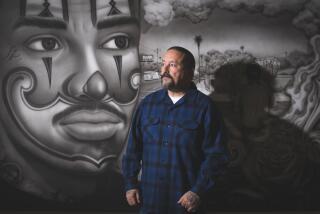From the ‘50s to your wall
- Share via
PAINT by number, the 1950s do-it-yourself art craze that swept the nation with the promise of “every man a Rembrandt,” apparently never died. It’s just been dozing for half a century, waiting for a new generation of technology, collectors and would-be artists to again succumb to its siren call.
These days, original paint-by-number canvases are considered collectibles, the best ones selling briskly on the Internet, at flea markets and in sidewalk bins at bargain shops. New paint-by-number firms pop up regularly, with a growing selection of subjects available online, at craft and hobby shops and in big box stores.
There is little nostalgic about the rebirth. It’s 21st century all the way. Today, computers do the job that took staffs of full-time artists, working by hand in the 1950s to deconstruct art works into paint-by-number canvases.
Now scan an image into a computer, and the machine spits out a page full of numbered segments to be filled in by amateur artists who weren’t even born when the first paint-by-number fad hit the scene.
People like Cathryn Barmon and Mark Deutsch, both 39, married 16 years. For most of that time, they shared their lives and Manhattan apartment with Pooh, a mixed-breed dog. “Pooh was such an important presence that when she died we found it hard to cope,” Barmon says. They’d noticed old paint-by-number pictures in nearby shops and decided to paint one themselves. “It would be a portrait, something hands-on that we could do together that would keep Pooh’s presence very close.”
They sent a favorite photo of their dog to easy123art.com, paid $90 and two weeks later received a kit with 42 paint colors, two brushes and a canvas that looked like a coloring-book page -- except that within each blank outlined space was a number that corresponded to a numbered container of paint.
The couple, who own a graphics and website design company, didn’t exactly color inside the lines. “We wanted to give it something extra, make it our own,” Barmon says. So they added colors and highlighted it with gold leaf paint. “Now it’s perfect. It hangs above our bed.”
The owner of easy123art, Aimee Cecil, 34, of Louisville, Ky., typifies the new paint-by-number entrepreneur. She’s the mother of two toddlers, has “a craftsy nature” and is totally attuned to technology.
Before starting her online pets and people portrait firm six years ago, she hired an expert to develop software that converts any photo portrait into a high quality paint-by-number format.
Cecil says she sells about 5,000 kits a year at an average cost of $90, and that business is picking up, especially in pet portraits. In 2005, the Color Wheel Co. in Philomath, Ore., came up with a personal computer software program that sells online for $28 (www.colorwheelco.com).
Company owner Ken Haines says the program makes it possible to use any photo to create numbered canvases at home with a personal computer. The software also prints out a shopping list of brushes and colors needed for the project. He sells about 2,000 programs a year, he says.
In its first incarnation, paint by number was a way for millions who’d never held a paintbrush to create what they thought of as “art” -- land and seascapes, puppies and kittens, sunsets and sailboats. With a bit of patience, anyone from 8 to 80 could paint a realistic likeness of any subject.
Of course, 1950s culture critics reviled the fad. It wasn’t art, they said. It was a tacky simulation, a low-intellect hobby, a pastime for the masses who lived in look-alike tract houses in newly built suburbs and were now painting look-alike pictures that came from a carton.
The masses couldn’t have cared less. In 1953, only two years into the paint-by-number craze, about $80 million dollars worth of kits were sold, at a cost of about $2.50 each.
That’s a lot of amateur Rembrandts, and a lot of paintings that have since found their way into flea markets and EBay auctions where some bids easily run up into the hundreds of dollars.
Poet Gayle Portnow has six vintage landscapes from flea markets in the guest room of her Camden, Maine, house. “They’re soothing, and all about nature ... they fit perfectly in a place like this.”
After the Smithsonian’s National Museum of American History held an exhibit of 1950s paint-by-numbers art in 2001, curator William L. Bird Jr. set up a site for people to express their thoughts. One woman wrote that an attorney in her “rather hip” Los Angeles law firm had an office awash in vintage paint-by-number art. Another remembered the healing effect the hobby had when she was fighting addictions.
Dan Robbins, 81, an originator of the paint-by-number concept, says he’s amazed that he and the hobby he helped start are still going strong.
Robbins was a commercial artist in 1950 when his boss, Max Klein, at Craft Master, asked him to develop an art project that families could do together. He came up with paint by number for adults. His boss loved it and so did the rest of the nation.
Sales soared from $200,000 to $20 million in just about five years, Robbins recalled in a phone interview from his Michigan home. And then, at the end of the ‘50s, the fad died, Robbins says. Then he corrects himself, “It didn’t die. It just went away for awhile.”
More proof that it’s back: Robbins was recently retained by the firm that bought the company he used to work for. “They want to manufacture paint-by-number kits again and asked my opinion on what subjects will sell.” Robbins hasn’t figured it out, he says, but he will.
*
Bettijane Levine can be reached at [email protected]
More to Read
Sign up for The Wild
We’ll help you find the best places to hike, bike and run, as well as the perfect silent spots for meditation and yoga.
You may occasionally receive promotional content from the Los Angeles Times.






